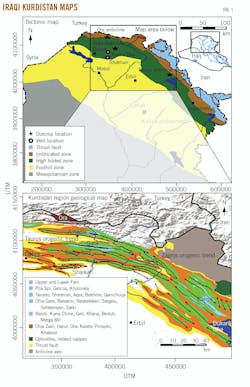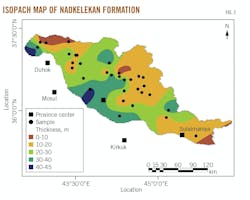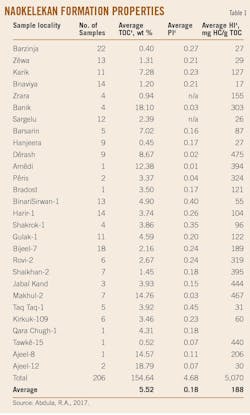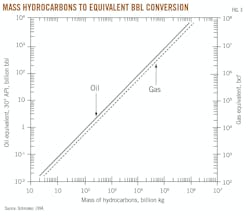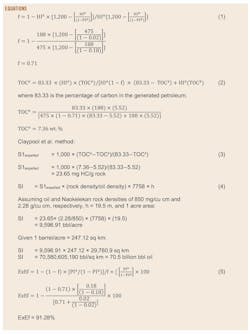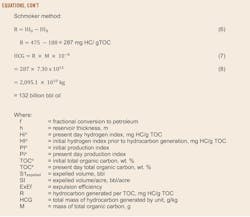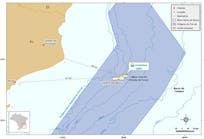Rzger Abdulkarim Abdula
Soran University
KRG, Iraq
This article calculates the amount of hydrocarbon generated from the Naokelekan formation in Iraqi Kurdistan. The Naokelekan formation source rock comprises part of the Zagros Mountain belt and contains mature organic matter within the oil generation window. The formation’s characteristics have been extensively studied, but its role in charging petroleum reservoirs has not been evaluated sufficiently.
The areal distribution, density, and weight of Naokelekan formation were determined using traditional methods and geographic information systems (GIS). Outcrop and bore hole samples provided data for two different methods to calculate ~70.5 and ~132 billion bbl of oil generated from the formation. The first method didn’t consider oil maturity, and the second therefore provides the more accurate analysis for the current condition of the reservoir.
Naokelekan formation analysis
Naokelekan formation crops out near the Naokelekan village, Rawanduz area, from the Balambo-Tanjero (Imbricated) zone in Iraqi Kurdistan (Fig. 1).1-5 Dark shaly inlayers in the Cudi Group could be equivalent to the Naokelekan formation in southeastern Turkey.6 This Upper Jurassic unit was deposited in an euxenic environment in a slow subsiding basin, but Al-Sayyab et al. reversed the sequence from bottom to top.7-11
The Callovian-Lower Kimmeridgian age was indicated by ammonite species in Iraqi Kurdistan. The same age was calculated by radiometric dating.12 Accordingly, a Middle Callovian-Early Kimmeridgian age for the Naokelekan formation was proposed. Naokelekan formation age was assigned to be Oxfordian-Kimmeridgian in age.13
The highly-condensed Naokelekan formation formed from a brackish lagoon and shallow open marine depositional environment and contains spores and pollen assemblages which are good indicators of a terrestrial or continental paleodepositional environment.14-17 Based on a Dêrash Valley and Banik area study, the depositional setting for Naokelekan formation specifically formed from salty swamps, marshes, and restricted tidal flats and lagoons under euxinic conditions.18 Naokelekan formation organic matter is mature and within the oil generation window in the Sargelu locality.19 The stratigraphy, organic geochemistry, palynology, and organic petrography of the formation in other parts of Iraqi Kurdistan has also been extensively studied.20-25 The Naokelekan formation was deposited in a ramp depositional setting.26
The database for this study consists of Rock-Eval pyrolysis measurements on surface outcrops and subsurface cuttings samples of the Naokelekan formation. Direct measurements provided thickness of the formation’s outcrops in different localities, and the Ministry of Natural Resources in Kurdistan Region provided thicknesses of subsurface sections.
GIS software drew the isopach map. Average thickness of the Naokelekan formation was also calculated by using GIS. Later, equations determined the weight of Naokelekan formation throughout the area. Original organic matter and original hydrogen index (HI) were determined by the method of Claypool, et al.27 The amount of generated petroleum was calculated based on the methods of Schmoker and Claypool.28
Geological setting
Iraq lies in the northeastern part of the Arabian Plate and contains the following tectonic zones: (I) Northern Thrust Zone, Zagros Thrust Zone, and Imbricated Zone; (II) Unstable Shelf (High Folded Zone and Foot Hill Zone); and (III) Stable Shelf (Mesopotamian Zone, Salman Zone, and Rutba-Jezira Zone). The studied region is part of the Zagros Mountain belt. This area is also distinguished by accompanying narrow synclines and asymmetric anticlines. The core of these anticlines contains Cretaceous and Jurassic rocks, whereas their sides are covered by clastic sedimentary and Tertiary limestone rocks.29 In all outcropping sections, the lower boundary of the Naokelekan formation with the underlain Sargelu formation is within a thin bedded limestone sequence.
Naokelekan formation lacks Bositra and chert bands that occur within the upper part of the Sargelu formation, and the formation is consistently overlain by the Barsarin formation with even and conformable contact.30 The thickness of the formation varies greatly throughout the region. The minimum formation thickness is 7 m at Banik and reaches 34-m maximum thickness at Ru Kuchuk.
The formation shows generally similar lithological composition and arrangement in all recognized occurrences. Based on field measurements and petrographic analysis, the tripartite division of the formation is recognizable in most sections. From bottom to top, the tripartite consists of (I) kerogenous limestone and dolomites, with intercalated kerogenous shale; (II) dolomitic limestone or limestones; and (III) laminated shaly kerogenous limestones. The formation was deposited in the Inner and Mid Ramp depositional sub-environment.
Hydrocarbon volume
The volume of Naokelekan formation can be determined by aerial distribution and mean thickness. From GIS calculation, the studied region encompassed 29,760.9 sq km. Average thickness from GIS calculations involving georeferencing and inverse distance weighting (Fig. 2) yielded an average thickness of 19.5 m. Average formation density came from samples from different lithological horizons and averaged 2,277.46 kg/cu m. The weight of the Naokelekan formation was subsequently calculated to be 1.322 × 1015 kg. Average present total organic carbon (TOC) in the formation is 5.52 wt.% and TOC weight calculated from reservoir weight averaged 7.30 × 1013 kg (Table 1).
Source rock potential
Petroleum generative capacity depends on the original total organic content (TOCo) and original hydrocarbon quality (HIo) of organic matter in thermally immature source rock.31 Schmoker proposed four steps for estimating the mass of petroleum generated within a petroleum system but did not consider the petroleum in the thermally immature source rocks, porosity loss during burial, and complications in determination of the original mass of the organic carbon. Claypool, et al. recognized that the hydrocarbon generation efficiency and volume of the petroleum generated from the source-rock could be calculated given TOC, total free hydrocarbons (S1), amount of hydrocarbon obtained by heating during pyrolysis (kerogen breakdown, S2), HI, and petroleum index (PI) pyrolysis data. Based on methods proposed by these researchers, the amount of generated petroleum will vary if rock parameter assumptions such as maturity differ between the analyses. The Schmoker method, specifically, is not applicable to immature source rock because it overestimates generated hydrocarbons.
Such calculations show that the results of the Claypool method are mostly consistent with the Schmoker method if the source rock is mature. In immature and early mature cases (e.g., Banik, Dêrash, Amêdi, Pêris, and Makhul-2), the amounts of original hydrocarbons and their generative capacities calculated by these two methods are not similar. Therefore, these methods are used to calculate amount of hydrocarbon generated from an active source rock.32
Formation volumetrics of Naokelekan source rock were determined using Claypool, et al. (Table 1). The available data are based on 206 samples (107 surface, 99 subsurface samples) of the rock which comprise Types II and III kerogens with average TOCx = 5.52 wt.%, HIx = 188 mg HC/g TOC, and PIx = 0.18 (Table 2).
Calculations determined the fractional conversion of source-rock organic matter to petroleum (f), TOCo, amount of expelled petroleum (S1expelled), and expulsion efficiency (ExEf). PIo and PIx, represent the original and measured production indices, respectively. Thermally immature source rocks assume PIo = 0.02. HIo is obtained from various methods. For example, if thermally immature equivalents of a mature source rock are available and spatial variations in organic facies are minimal, then measured HI (HIx) can be assumed to equal HIo.
HIo for immature equivalents of the Naokelekan source rock is about 475 mg HC/g TOC. Given HIo = 475 mg HC/g TOC and PIo = 0.02, the extent of the petroleum-generation process, or the fractional conversion to petroleum, calculated from Equation 1, is f = 0.71. The original TOC (TOCo = 7.36%) calculated from Equation 2 for the source rock before maturation is constrained by mass balance considerations.
Expelled petroleum volume
Claypool’s method determines the amount of generated petroleum using Equations 3-5 and data in Table 2. The method calculates an expulsion efficiency (ExEf) of 91.28% and expelled oil volume of 70.5 billion bbl. Schmoker’s flow diagram method for generated hydrocarbon mass uses Equations 6-8 and data in Table 2, and it estimates 132 billion bbl expelled oil with no methane. The 61.5 billion bbl difference between Claypool and Schmoker methods stems from reservoir maturity which is not considered by Claypool.
An expelled volume analysis by Aqrawi and Badies suggests that the formation could generate 585 billion bbl and 146 billion boe gas, but this was based on a larger reservoir volume (2,787 cu km), albeit with more immature rocks (3.50 wt.% mean TOC and 450 mg HC/g TOC HI) compared with the models in this study.33 The modeling focused on in this paper comprises more accurate boundaries of the Naokelekan formation.
References
- Bellen, R.C. Dunnington, H.V., Wetzel, R., and Morton, D.M., “Lexique stratigraphic international,” Vol. III, Asie, Fascicule 10a Iraq, 1959.
- Jassim, S.Z. and Buday, T., “Units of the Unstable Shelf and the Zagros Suture,” Geology of Iraq, 2006b, pp. 73–90.
- Sissakian, V.K., Hagopian, D.H., and Ma’ala, Kh.A., “Geological map of Mosul quadrangle, scale 1: 250000,” Iraq Geological Survey Publications, Baghdad, Iraq, 1995.
- Sissakian, V.K., “Geological map of Arbeel and Mahabad quadrangles, sheets NJ 38- 14 and NJ-38-15., scale 1:250000,” State Establishment of Geological Survey and Mining. GEOSURV, Baghdad, Iraq, 1997.
- Csontos, L., Sasvari, A., Pocasai, T., Kosa, L., Salae, A.T., and Ali, A., “Structural evolution of the Northwestern Zagros, Kurdistan Region, Iraq: Implications on oil migration,” GeoArabia, Vol. 17, No. 2, 2012, pp. 81–116.
- Altinli, I.E., “Geology of eastern and southeastern Anatolia, Turkey,” Bulletin of Mineral Research Exploration Institute of Turkey, Foreign Edition, Ankara, no. 60, 1966, pp. 35–76.
- Al-Omari, F.S. and Sadiq, A., “Geology of northern Iraq,” Mosul University Press, Mosul, Iraq, 1977.
- Buday, T., “The regional geology of Iraq, Vol. 1, stratigraphy and paleogeography,” Dar Al-Kutub Publishing House, University of Mosul, Mosul, Iraq, 1980.
- Alsharhan, A.S. and Nairn, A.E.M., “Sedimentary basins and petroleum geology of the Middle East,” Elsevier Science BV, Amsterdam, Netherlands, 2003.
- Jassim, S.Z. and Buday, T., “Late Toarcian-Early Tithonian (Mid-Late Jurassic) Megasequence AP7,” Geology of Iraq, 2006a, pp. 145–155.
- Al-Sayyab, A., Al-Ansari, N., Al-Rawi, D., Al-Jassim, J., Al-Omari, F., and Al-Shaikh, Z., “Geology of Iraq,” Mosul University Press, Mosul, Iraq, 1982.
- Howarth, M.K. and Donovan, D.T., “Ammonites of the Liassic family Juraphyllitidae in Britain,” Palaeontology, Vol. 7, No. 2, July 1964, pp. 286–305.
- Ibrahim, M.W., “Chronometry of the Late Jurassic in the Middle East-a review,” Revue De L’Institute Francais Du Petrole, Vol. 36, No. 5, September – October 1981, pp. 595–606.
- Ahmed, M.A., “Sedimentary facies and depositional environments of Jurassic rocks, NW Iraq,” Ph.D. dissertation (unpublished), Science College, University of Mosul, Mosul, Iraq, 1997.
- Salae, A.T.S., “Stratigraphy and sedimentology of the Upper Jurassic succession, northern Iraq,” Master’s thesis (unpublished), Science College, University of Baghdad, Baghdad, Iraq, 2001.
- Ahmed, A.A. and Al-Gibouri, A.S., “Geochemical and palynological analysis in assessing hydrocarbon potential and palaeoenvironmental deposition, north Iraq,” Journal of Petroleum Research & Studies, Vol. 2, No. 1, Issue 2, Feb. 1, 2011, pp. 98–116.
- Aqrawi, A.A.M., Horbury, A.D., Goff, J.C., and Sadooni, F.N., “The petroleum geology of Iraq,” Scientific Press Ltd., Staines-Upon-Thames, UK, 2010.
- Al-Badry, A.M.S., “Stratigraphy and geochemistry of Jurassic formations in selected sections – north Iraq,” Ph.D. dissertation (unpublished), Science College, University of Baghdad, Iraq, January 2012.
- Baban, D.H. and Ahmed, S.M., “Vitrinite reflectance as a tool for determining level of thermal maturity for the Upper Jurassic Naokelekan and Barsarin formations in Sargelu location, Kurdistan Region, NE Iraq,” Arabian Journal of Geosciences, Vol. 7, No. 6, April 9, 2014, pp. 2269–2277.
- Abdula, R.A, “Stratigraphy and lithology of Naokelekan Formation in Iraqi Kurdistan: Review,” The International Journal of Engineering and Science (IJES), Vol. 5, No. 8, August 2016, pp. 7-17.
- Abdula, R.A., “Source rock assessment of Naokelekan Formation in Iraqi Kurdistan,” Journal of Zankoy Sulaimani, Vol. 19, No. 1, Issue 36, March 20, 2017, pp. 103-124.
- Abdula, R.A., “Organic petrography, mineralogy, Rock-Eval pyrolysis, of Naokelekan Formation and hydrocarbon generation history in upper Triassic-Jurassic sequences in Kurdistan region, Iraq,” Ph.D. dissertation (unpublished), Science Faculty, Soran University, Iraq, October 2018.
- Abdula, R.A., Kolo, K., Raftopoulou, V., Khanaqa, P., and Kalaitzidis, S., “Petrographical features of organic matter from upper Jurassic Naokelekan Formation, Kurdistan-Iraq: A study on regional thermal maturity trends,” Part V, Chapter 30, Advances in Engineering Petroleum Geochemistry, Proceedings of the 1st Springer Conference of the Arabian Journal of Geosciences (CAJG-1), Tunisia 2018, pp. 127-130.
- Abdula, R.A., Abdulla, M.I., Salih, N.A.M., Isa, S.A., and Hashmi, H.S.K., “Hydrocarbon potentiality and depositional environment of Naokelekan Formation in Binari Serwan-1 Well, NE-Iraq using infrared factors and palynological analysis evidence,” Tikrit Journal of Pure Science, Vol. 25, No. 2, 2020a, pp. 54-63.
- Abdula, R.A., Kolo, K., Damoulianou, M., Raftopoulou, V., Khanaqa, P., and Kalaitzidis, S., “Rock-Eval analysis and organic petrographical characterization of the Upper Jurassic Naokelekan Formation, northern Mesopotamian basin, Kurdistan Region-Iraq,” Bulletin of the Geological Society of Greece, Vol. 56, No. 1, July 23, 2020, pp. 187-203.
- Sharezwri, A.O.H., Nourmohamadi, M.S., and Abdula, R.A., “Facies analysis and depositional environment of the Upper Jurassic Naokelekan Formation in selected outcrop sections, Kurdistan region, NE Iraq,” Iraqi Bulletin of Geology and Mining, Vol. 16, no. 1, June 1, 2020, pp. 1–14.
- Claypool, G.K., Peters, K.E., and Wildharber, J., “Exploration geochemistry reference guide,” Modern geochemical tools for efficient exploitation and development, Tulsa, Okla.: OGCI Training, 1998.
- Schmoker, J.W., “Volumetric calculation of hydrocarbons generated,” The Petroleum system from source to trap, AAPG Special Volumes, M60, 1994, pp. 323–326.
- Ameen, M.S., “Effect of basement tectonics on hydrocarbon generation, migration, and accumulation in northern Iraq,” AAPG Bulletin, Vol. 76, No. 3, March 1992, pp. 356–370.
- Abdula, R.A., Balaky, S.M., Nurmohamadi, M.S., and Piroui, M., “Microfacies analysis and depositional environment of the Sargelu Formation (Middle Jurassic) from Kurdistan region, northern Iraq,” Donnish Journal of Geology and Mining Research, Vol. 1, No. 1, March 2015, pp. 001–026.
- Peters, K.E., Walters, C.C., and Moldowan, J.M., “The biomarker guide, second edition, volume I, biomarkers and isotopes in petroleum systems and human history,” Cambridge University Press, UK, 2005.
- El Nady, M.M., “The Volumetric Calculation of Hydrocarbons Generation of Source Rocks in the Gulf of Suez, Egypt,” Petroleum Science and Technology, Vol. 31, Jan. 11, 2013, pp. 310–320.
- Aqrawi, A.M. and Badics, B., “Geochemical characterisation, volumetric assessment and shale-oil/gas potential of the Middle Jurassic–Lower Cretaceous source rocks of NE Arabian Plate,” GeoArabia, Gulf PetroLink, Bahrain, Vol. 20, No. 3, July 1, 2015, pp. 99-140.
The author
Rzger Abdulkarim Abdula ([email protected]) is a professor at Soran University in Soran, KRG-Iraq and adjacent lecturer at Tishk International University, Department of Petroleum and Mining Engineering in Erbil, KRG-Iraq. He holds a BS in geology (1987) from the University of Salahaddin-Erbil, Iraq, an MS in geology from the Colorado School of Mines, and PhD in Petroleum Geology from the Soran University.
